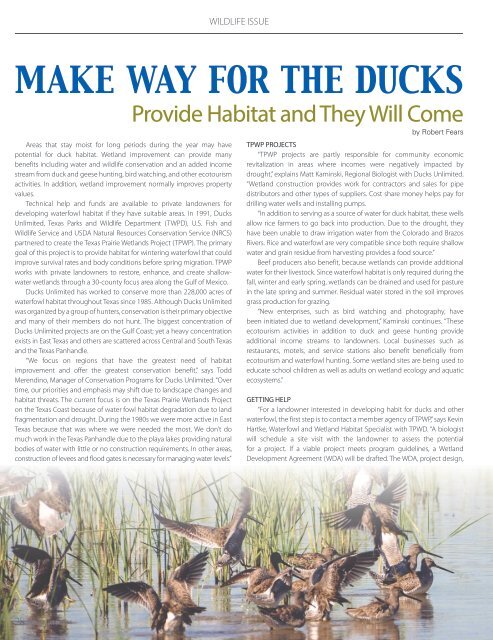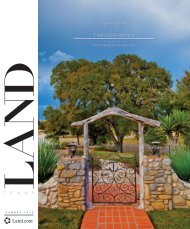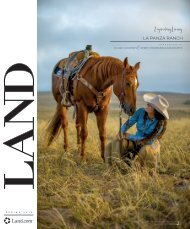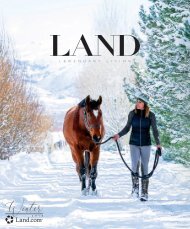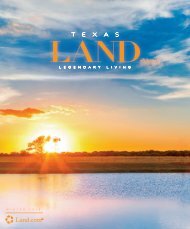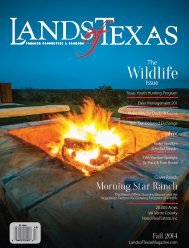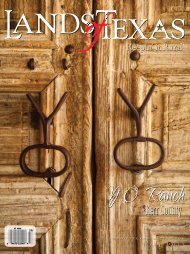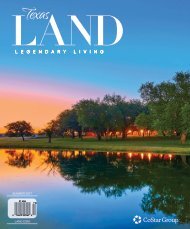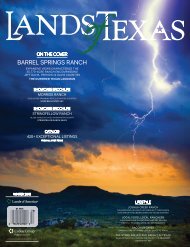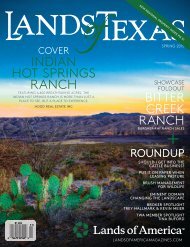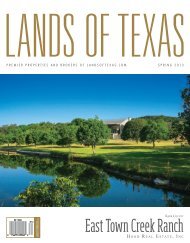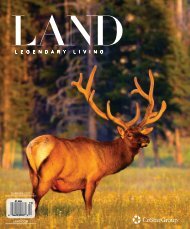You also want an ePaper? Increase the reach of your titles
YUMPU automatically turns print PDFs into web optimized ePapers that Google loves.
WILDLIFE ISSUE<br />
MAKE WAY FOR THE DUCKS<br />
Areas that stay moist for long periods during the year may have<br />
potential for duck habitat. Wetland improvement can provide many<br />
benefits including water and wildlife conservation and an added income<br />
stream from duck and geese hunting, bird watching, and other ecotourism<br />
activities. In addition, wetland improvement normally improves property<br />
values.<br />
Technical help and funds are available to private landowners for<br />
developing waterfowl habitat if they have suitable areas. In 1991, Ducks<br />
Unlimited, <strong>Texas</strong> Parks and Wildlife Department (TWPD), U.S. Fish and<br />
Wildlife Service and USDA Natural Resources Conservation Service (NRCS)<br />
partnered to create the <strong>Texas</strong> Prairie Wetlands Project (TPWP). The primary<br />
goal of this project is to provide habitat for wintering waterfowl that could<br />
improve survival rates and body conditions before spring migration. TPWP<br />
works with private landowners to restore, enhance, and create shallowwater<br />
wetlands through a 30-county focus area along the Gulf of Mexico.<br />
Ducks Unlimited has worked to conserve more than 228,000 acres of<br />
waterfowl habitat throughout <strong>Texas</strong> since 1985. Although Ducks Unlimited<br />
was organized by a group of hunters, conservation is their primary objective<br />
and many of their members do not hunt. The biggest concentration of<br />
Ducks Unlimited projects are on the Gulf Coast; yet a heavy concentration<br />
exists in East <strong>Texas</strong> and others are scattered across Central and South <strong>Texas</strong><br />
and the <strong>Texas</strong> Panhandle.<br />
“We focus on regions that have the greatest need of habitat<br />
improvement and offer the greatest conservation benefit,” says Todd<br />
Merendino, Manager of Conservation Programs for Ducks Unlimited. “Over<br />
time, our priorities and emphasis may shift due to landscape changes and<br />
habitat threats. The current focus is on the <strong>Texas</strong> Prairie Wetlands Project<br />
on the <strong>Texas</strong> Coast because of water fowl habitat degradation due to land<br />
fragmentation and drought. During the 1980s we were more active in East<br />
<strong>Texas</strong> because that was where we were needed the most. We don’t do<br />
much work in the <strong>Texas</strong> Panhandle due to the playa lakes providing natural<br />
bodies of water with little or no construction requirements. In other areas,<br />
construction of levees and flood gates is necessary for managing water levels.”<br />
Provide Habitat and They Will Come<br />
by Robert Fears<br />
TPWP PROJECTS<br />
“TPWP projects are partly responsible for community economic<br />
revitalization in areas where incomes were negatively impacted by<br />
drought,” explains Matt Kaminski, Regional Biologist with Ducks Unlimited.<br />
“Wetland construction provides work for contractors and sales for pipe<br />
distributors and other types of suppliers. Cost share money helps pay for<br />
drilling water wells and installing pumps.<br />
“In addition to serving as a source of water for duck habitat, these wells<br />
allow rice farmers to go back into production. Due to the drought, they<br />
have been unable to draw irrigation water from the Colorado and Brazos<br />
Rivers. Rice and waterfowl are very compatible since both require shallow<br />
water and grain residue from harvesting provides a food source.”<br />
Beef producers also benefit, because wetlands can provide additional<br />
water for their livestock. Since waterfowl habitat is only required during the<br />
fall, winter and early spring, wetlands can be drained and used for pasture<br />
in the late spring and summer. Residual water stored in the soil improves<br />
grass production for grazing.<br />
“New enterprises, such as bird watching and photography, have<br />
been initiated due to wetland development,” Kaminski continues. “These<br />
ecotourism activities in addition to duck and geese hunting provide<br />
additional income streams to landowners. Local businesses such as<br />
restaurants, motels, and service stations also benefit beneficially from<br />
ecotourism and waterfowl hunting. Some wetland sites are being used to<br />
educate school children as well as adults on wetland ecology and aquatic<br />
ecosystems.”<br />
GETTING HELP<br />
“For a landowner interested in developing habit for ducks and other<br />
waterfowl, the first step is to contact a member agency of TPWP,” says Kevin<br />
Hartke, Waterfowl and Wetland Habitat Specialist with TPWD. “A biologist<br />
will schedule a site visit with the landowner to assess the potential<br />
for a project. If a viable project meets program guidelines, a Wetland<br />
Development Agreement (WDA) will be drafted. The WDA, project design,<br />
28<br />
<strong>Fall</strong> <strong>2014</strong>


